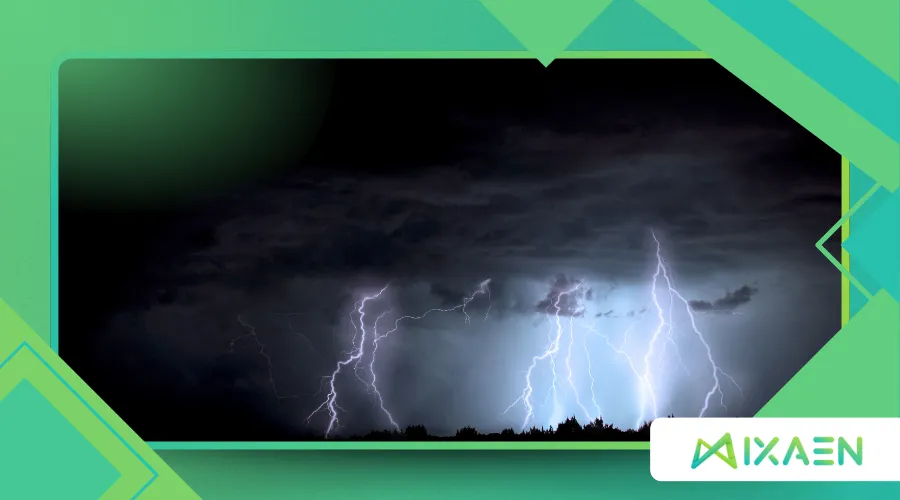The Sun’s Role in Triggering Earth’s Geomagnetic Storms

Geomagnetic storms, those electrifying disruptions in Earth’s magnetic field, originate from our closest star—the Sun.
Anúncios
These cosmic events, driven by solar activity, ripple through space, impacting technology, climate, and even human exploration.
But what makes the Sun such a powerful conductor of these magnetic symphonies?
Let’s dive into the science, unraveling how solar phenomena spark these storms, why they matter, and what’s at stake for our tech-driven world.
The Sun’s influence extends beyond mere physical phenomena; it also plays a crucial role in shaping our understanding of space weather and its implications for life on Earth.
The Sun’s Fiery Temper: Solar Flares and Coronal Mass Ejections
Imagine the Sun as a cosmic chef, simmering with energy and occasionally tossing out fiery ingredients into space.
Solar flares, intense bursts of radiation, and coronal mass ejections (CMEs), massive clouds of charged particles, are the Sun’s most potent recipes for geomagnetic storms.
When a CME hurtles toward Earth at speeds up to 6.7 million mph, it carries billions of tons of plasma capable of compressing our planet’s magnetosphere.
Unlike flares, which primarily emit X-rays and ultraviolet light, CMEs deliver a physical punch.
When these plasma clouds collide with Earth’s magnetic field, they trigger geomagnetic storms by injecting energy into the magnetosphere.
A 2023 study from the National Oceanic and Atmospheric Administration (NOAA) found that CMEs associated with X-class flares—the most powerful type—caused 78% of severe geomagnetic storms between 2015 and 2022.
The relationship between solar activity and geomagnetic storms is a complex dance that scientists continue to study, revealing insights into the Sun’s behavior and its effects on Earth.
Example 1: The 2024 Solar Surge
In May 2024, a series of X-class flares unleashed a CME that sparked a G5 geomagnetic storm—the highest severity level.
This event disrupted GPS signals across North America, forcing farmers in the Midwest to pause autonomous tractor operations during planting season.
The Magnetosphere’s Dance with Solar Winds
Earth’s magnetosphere, our planet’s invisible shield, doesn’t just sit idly by.
It’s a dynamic barrier, constantly reshaped by solar winds—streams of charged particles flowing from the Sun.
During a geomagnetic storm, these winds intensify, stretching and compressing the magnetosphere like a rubber band.
This interaction excites particles in the upper atmosphere, creating auroras but also destabilizing satellites and power grids.
The strength of a geomagnetic storm depends on the CME’s magnetic orientation.
If the CME’s magnetic field aligns oppositely to Earth’s, the two fields reconnect, funneling energy into the magnetosphere.
This process, known as magnetic reconnection, acts like a cosmic handshake that amplifies the storm’s impact.
Understanding this interaction is crucial for developing better predictive models for geomagnetic storms and mitigating their effects on technology.
For further reading on the science of geomagnetic storms, you can visit NASA’s Space Weather website.
Table 1: Geomagnetic Storm Classification (NOAA Scale)
| G-Scale | Effects | Frequency (Per Solar Cycle) |
|---|---|---|
| G1 (Minor) | Weak power grid fluctuations, minor satellite issues | ~1,700 |
| G3 (Moderate) | GPS degradation, high-latitude radio blackouts | ~300 |
| G5 (Extreme) | Widespread power outages, satellite failures | ~4 |
Impacts on Technology: A Growing Vulnerability
Why should we care about geomagnetic storms?
Our reliance on technology makes us more vulnerable than ever.
Satellites, critical for communication and navigation, face increased drag and radiation exposure during storms.
In 2022, SpaceX lost 38 Starlink satellites after a moderate geomagnetic storm increased atmospheric density, pulling them out of orbit.
Power grids are equally at risk.
Geomagnetic storms induce currents in long-distance power lines, potentially overloading transformers.
The 1989 Quebec blackout, caused by a G5 storm, left 6 million people without power for nine hours.
Today, with our interconnected grids, a similar event could cost billions.
A 2021 Lloyd’s of London report estimated that a Carrington-level storm—a rare, extreme event like the one in 1859—could cause $2.6 trillion in damages globally.
As we become increasingly dependent on technology, the potential impact of geomagnetic storms will only grow, making it essential to develop strategies for resilience.
Statistic: NOAA recorded 27 G3 or higher geomagnetic storms in 2024, a 40% increase from the previous year, signaling heightened solar activity as we approach the solar maximum in mid-2025.

Climate Connections: A Subtle Influence
While geomagnetic storms are best known for their technological impacts, their role in Earth’s climate is less obvious but intriguing.
Solar activity influences cosmic rays—high-energy particles from deep space—that affect cloud formation.
During periods of high solar activity, fewer cosmic rays reach Earth, potentially reducing low-altitude cloud cover and subtly warming the planet.
This connection remains controversial, but a 2020 study in Nature suggested that solar-induced geomagnetic activity could account for up to 0.1°C of global temperature variability over a century.
While small, this effect underscores the Sun’s far-reaching influence beyond immediate geomagnetic storms.
Research continues to explore how variations in solar activity may correlate with climate patterns, providing insights into long-term climate change.
Example 2: The Arctic Research Station
In 2023, researchers at an Arctic climate station noticed unusual temperature spikes during a G4 geomagnetic storm.
Instruments detected increased ionospheric activity, hinting at localized atmospheric heating driven by solar particles.
+ The End of the Sun: When and How Our Star Will Die, According to Science
The Human Frontier: Space Exploration Risks
As humanity eyes Mars and beyond, geomagnetic storms pose a growing challenge.
Astronauts outside Earth’s magnetosphere face heightened radiation risks during CME-driven storms.
A single event could expose them to a year’s worth of radiation in hours, increasing cancer risks.
NASA’s Artemis program, aiming for lunar missions by 2026, includes radiation shelters in spacecraft designs to mitigate this threat.
On Earth, airlines reroute polar flights during storms to avoid radiation exposure and communication disruptions.
In 2024, Delta Air Lines reported rerouting 12 transpolar flights during a G4 storm, costing an estimated $1.2 million in fuel and delays.
As we expand our exploration of space, understanding and mitigating the risks posed by geomagnetic storms will be critical for the safety of astronauts and the success of missions.
Table 2: Radiation Exposure During Geomagnetic Storms
| Scenario | Radiation Dose (mSv) | Equivalent Chest X-Rays |
|---|---|---|
| G1 Storm (Ground Level) | 0.01 | 0.1 |
| G5 Storm (Polar Flight) | 0.5 | 5 |
| G5 Storm (Low Earth Orbit) | 10 | 100 |

Forecasting the Cosmic Weather
Predicting geomagnetic storms is like forecasting a hurricane with half the data.
Scientists rely on solar observatories like NASA’s Solar Dynamics Observatory (SDO) to monitor flares and CMEs.
However, pinpointing a CME’s magnetic orientation remains tricky, limiting forecast accuracy to 12–24 hours.
Advances in machine learning are improving predictions, with a 2024 algorithm from MIT achieving 85% accuracy in forecasting G3 or higher storms.
Public awareness is also rising.
NOAA’s Space Weather Prediction Center now issues alerts via mobile apps, helping industries like aviation and energy prepare.
But as solar cycle 25 peaks, the question looms: Are we ready for the next big storm?
The accuracy of forecasts will become increasingly important as we face more frequent and intense geomagnetic storms.
++ Coronal Hole Explained: Everything About This Opening in the Sun’s Magnetic Field
A Cosmic Analogy: The Sun as a Symphony Conductor
Picture the Sun as a symphony conductor, wielding its magnetic baton to orchestrate geomagnetic storms.
Each flare and CME is a note, resonating through space to create a crescendo that shakes Earth’s magnetic field.
Sometimes, the music is soft, producing auroras; other times, it’s a chaotic forte, threatening our technological harmony.
This analogy reminds us that the Sun’s influence is both beautiful and formidable.
Recognizing the Sun’s dual role as a nurturer and disruptor can help us better appreciate its impact on our lives and technology.
Looking Ahead: Mitigating the Risks
Reducing the impacts of geomagnetic storms requires innovation and preparedness.
Hardening power grids with neutral blockers, designing radiation-resistant satellites, and improving space weather forecasts are critical steps.
International collaboration is also key—space weather knows no borders.
The United Nations’ Committee on the Peaceful Uses of Outer Space has prioritized space weather research, urging nations to share data and resources.
Individuals can play a role, too.
During a storm, unplugging sensitive electronics and staying informed via NOAA alerts can minimize risks.
As solar activity intensifies, staying proactive is our best defense.
Building a culture of preparedness and resilience will be essential as we face the challenges posed by geomagnetic storms.
Conclusion: The Sun’s Influence in a Connected World
The Sun’s role in triggering geomagnetic storms reveals its dual nature as both a life-sustaining star and a cosmic disruptor.
From dazzling auroras to costly blackouts, these events remind us of our place in the universe governed by stellar forces.
As we navigate the peak of solar cycle 25, understanding and preparing for these storms will shape our technological resilience and exploratory ambitions.
Will we harness the Sun’s cosmic symphony, or be drowned out by its power?
The choice lies in our ability to adapt and innovate.
By fostering a deeper understanding of solar activity and its effects, we can better prepare for the challenges that lie ahead.
